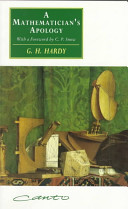Mathematics Lies Outside Ourselves
I believe that mathematical reality lies outside us, that our function is to discover or observe it, and that the theorems which we prove, and which we describe grandiloquently as our "creations," are simply the notes of our observations.
* * *
Let us suppose that I am giving a lecture on some system of geometry, such as the ordinary Euclidean geometry, and that I draw figures on the blackboard to stimulate the imagination of my audience, rough drawings of straight lines or circles or ellipses. It is plain, first, that the truth of the theorems which I prove is in no way affected by the quality of my drawings. Their function is merely to bring home my meaning to my hearers, and, if I can do that, there would be no gain in having them redrawn by the most skilful draughtsman. They are pedagogical illustrations, not part of the real subject-matter of the lecture.
Now let us go a stage further. The room in which I am lecturing is a part of the physical world, and has itself a certain pattern. The study of that pattern, and of the general pattern of physical reality, is a science in itself, which we may call `physical geometry'. Suppose now that a violent dynamo, or a massive gravitating body, is introduced into the room. Then the physicists tell us that the geometry of the room is changed, its whole physical pattern slightly but definitely distorted. Do the theorems which I have proved become false? Surely it would be nonsense to suppose that the proofs of them which I have given are affected in any way. It would be like supposing that a play of Shakespeare is changed when a reader spills histea over a page. The play is independent of the pages on which it is printed, and `pure geometries' are independent of lecture rooms, or of any other detail of the physical world.
This is the point of view of a pure mathematician. Applied mathematicians, mathematical physicists, naturally take a different view, since they are preoccupied with the physical world itself, which also has its structure or pattern. We cannot describe this pattern exactly, as we can say that of a pure geometry, but we can say something significant about it. We can describe, sometimes fairly accurately, sometimes very roughly, the relations which hold between some of its constituents, and compare them with the exact relations holding between constituents of some system of pure geometry. We may be able to trace a certain resmeblance between the two sets of relations, and then the pure geometry will become interesting to physicists; it will give us, to that extent, a map which `fits the facts' of the physical world. The geometer offers to the physicist a whole set of maps from which to choose. One map, perhaps, will fit the facts better than others, and then the geometry that provides that particular map will be the geometry most important for applied mathematics. I may add that even a pure mathematician may find his appreciation of this geometry quickened, since there is no mathematician so pure that he feels no interest at all in the physical world; but, in so far as he succumbs to this temptation, he will be abandoning his purely mathematical position.
* * *
It may be that modern physics fits best into some framework of idealistic philosophy -- I do not believe it, but there are eminent physicists who say so. Pure mathematics, on the other hand, seems to me a rock on all which all idealism founders: 317 is a prime, not because we think so, or because our minds are shaped in one way rather than another, but because it is so, because mathematical reality is built that way.
Notes:
When teaching mathematics, it does not matter how nice the drawings or the teaching space, the ideas are what's important and they are independent of the teaching method.
Folksonomies: education mathematics teaching
Taxonomies:
/science/mathematics/geometry (0.685830)
/science/mathematics (0.437204)
/hobbies and interests/magic and illusion (0.381704)
Keywords:
physical world (0.961944 (negative:-0.176552)), pure geometry (0.803776 (positive:0.307296)), ordinary Euclidean geometry (0.755106 (neutral:0.000000)), pure mathematician (0.751511 (positive:0.478913)), mathematical reality (0.738228 (neutral:0.000000)), massive gravitating body (0.732843 (negative:-0.387974)), pattern (0.681547 (neutral:0.000000)), skilful draughtsman (0.648656 (positive:0.504227)), Pure mathematics (0.646163 (neutral:0.000000)), physical pattern (0.646068 (neutral:0.000000)), general pattern (0.640358 (neutral:0.000000)), certain pattern (0.638295 (neutral:0.000000)), physical geometry (0.635081 (neutral:0.000000)), physicists (0.634053 (positive:0.365172)), teaching space (0.633799 (neutral:0.000000)), teaching method (0.633506 (positive:0.573482)), mathematical physicists (0.629878 (neutral:0.000000)), teaching mathematics (0.627757 (neutral:0.000000)), idealistic philosophy (0.627329 (positive:0.478864)), straight lines (0.626902 (neutral:0.000000)), violent dynamo (0.625648 (neutral:0.000000)), physical reality (0.620929 (neutral:0.000000)), modern physics (0.619184 (positive:0.537810)), certain resmeblance (0.617104 (neutral:0.000000)), idealism founders (0.616849 (positive:0.326662)), different view (0.613975 (positive:0.513837)), exact relations (0.613653 (positive:0.220690)), particular map (0.610640 (positive:0.257441)), theorems (0.608507 (negative:-0.578399)), mathematical position (0.608357 (neutral:0.000000))
Entities:
physicist:JobTitle (0.859050 (positive:0.110984))
Concepts:
Mathematics (0.964269): dbpedia | freebase | opencyc
Geometry (0.659300): dbpedia | freebase | opencyc
Pure mathematics (0.506153): dbpedia | freebase | opencyc
Physics (0.484417): dbpedia | freebase | opencyc
Applied mathematics (0.473704): dbpedia | freebase
Pythagorean theorem (0.398476): dbpedia | freebase | yago
Axiom (0.398143): dbpedia | freebase
Function (0.386168): dbpedia | freebase | yago





